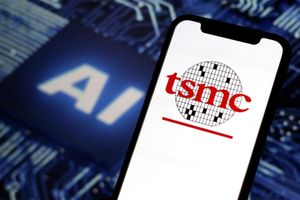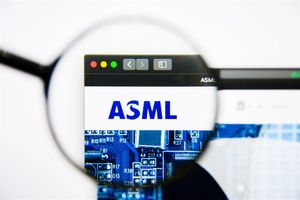
Veldhoven, Netherlands – October 16, 2025 – ASML Holding N.V. (AMS: ASML), the Dutch giant and sole manufacturer of advanced Extreme Ultraviolet (EUV) lithography systems, has seen its stock climb significantly this week, driven by a stellar third-quarter earnings report, unprecedented demand for its cutting-edge technology, and an optimistic outlook fueled by the insatiable appetite of the artificial intelligence (AI) sector. The semiconductor industry’s bedrock, ASML, finds itself at the epicenter of a technological revolution, with its specialized machinery becoming increasingly indispensable for producing the next generation of AI-powered chips.
The company's strong performance underscores its pivotal role in the global technology ecosystem. As the world races to develop more sophisticated AI models and applications, the need for smaller, more powerful, and energy-efficient semiconductors has never been greater. ASML’s EUV technology is the bottleneck-breaking solution, enabling chipmakers to push the boundaries of Moore’s Law and deliver the processing power required for advanced AI, from large language models to complex neural networks.
Unpacking the Technical Edge: EUV and the Dawn of High-NA
ASML's recent surge is firmly rooted in its technological dominance, particularly its Extreme Ultraviolet (EUV) lithography. The company's third-quarter 2025 results, released on October 15, revealed net bookings of €5.4 billion, significantly exceeding analyst expectations. A staggering €3.6 billion of this was attributed to EUV systems, highlighting the robust and sustained demand for its most advanced tools. These systems are critical for manufacturing chips with geometries below 5 nanometers, a threshold where traditional Deep Ultraviolet (DUV) lithography struggles due to physical limitations of light wavelengths.
EUV lithography utilizes a much shorter wavelength of light (13.5 nanometers) compared to DUV (typically 193 nanometers), allowing for the printing of significantly finer patterns on silicon wafers. This precision is paramount for creating the dense transistor layouts found in modern CPUs, GPUs, and specialized AI accelerators. Beyond current EUV, ASML is pioneering High Numerical Aperture (High-NA) EUV, which further enhances resolution and enables even denser chip designs. ASML recognized its first revenue from a High-NA EUV system in Q3 2025, marking a significant milestone. Key industry players like Samsung (KRX: 005930) are slated to receive ASML's High-NA EUV machines (TWINSCAN EXE:5200B) by mid-2026 for their 2nm and advanced DRAM production, with Intel (NASDAQ: INTC) and Taiwan Semiconductor Manufacturing Company (TSMC) (NYSE: TSM) already deploying prototype systems. This next-generation technology is crucial for extending Moore's Law into the sub-2nm era, enabling the exponentially increasing computational demands of future AI.
AI's Indispensable Enabler: Impact on Tech Giants and the Competitive Landscape
ASML’s unparalleled position as the sole provider of EUV technology makes it an indispensable partner for the world's leading chip manufacturers. Companies like TSMC, Intel, and Samsung are heavily reliant on ASML's equipment to produce the advanced semiconductors that power everything from smartphones to data centers and, crucially, the burgeoning AI infrastructure. The strong demand for ASML's EUV systems directly reflects the capital expenditures these tech giants are making to scale up their advanced chip production, a substantial portion of which is dedicated to meeting the explosive growth in AI hardware.
For AI companies, both established tech giants and innovative startups, ASML's advancements translate directly into more powerful and efficient computing resources. Faster, smaller, and more energy-efficient chips enable the training of larger AI models, the deployment of AI at the edge, and the development of entirely new AI applications. While ASML faces competition in other segments of the semiconductor equipment market from players like Applied Materials (NASDAQ: AMAT) and Lam Research (NASDAQ: LRCX), its near-monopoly in EUV lithography creates an unassailable competitive moat. This strategic advantage positions ASML not just as a supplier, but as a foundational enabler shaping the competitive landscape of the entire AI industry, determining who can produce the most advanced chips and thus, who can innovate fastest in AI.
Broader Significance: Fueling the AI Revolution and Geopolitical Chess
The continued ascent of ASML underscores its critical role in the broader AI landscape and global technological trends. As AI transitions from a niche technology to a pervasive force, the demand for specialized hardware capable of handling immense computational loads has surged. ASML's lithography machines are the linchpin in this supply chain, directly impacting the pace of AI development and deployment worldwide. The company's ability to consistently innovate and deliver more advanced lithography solutions is fundamental to sustaining Moore's Law, a principle that has guided the semiconductor industry for decades and is now more vital than ever for the AI revolution.
However, ASML's strategic importance also places it at the center of geopolitical considerations. While the company's optimistic outlook is buoyed by strong overall demand, it anticipates a "significant" decline in DUV sales to China in 2026 due to ongoing export restrictions. This highlights the delicate balance ASML must maintain between global market opportunities and international trade policies. The reliance of major nations on ASML's technology for their advanced chip aspirations has transformed the company into a key player in the global competition for technological sovereignty, making its operational health and technological advancements a matter of national and international strategic interest.
The Road Ahead: High-NA EUV and Beyond
Looking ahead, ASML's trajectory is set to be defined by the continued rollout and adoption of its High-NA EUV technology. The first revenue recognition from these systems in Q3 2025 is just the beginning. As chipmakers like Samsung, Intel, and TSMC integrate these machines into their production lines over the next year, the industry can expect a new wave of chip innovation, enabling even more powerful and efficient AI accelerators, advanced memory solutions, and next-generation processors. This will pave the way for more sophisticated AI applications, from fully autonomous systems and advanced robotics to personalized medicine and hyper-realistic simulations.
Challenges, however, remain. Navigating the complex geopolitical landscape and managing export controls will continue to be a delicate act for ASML. Furthermore, the immense R&D investment required to stay at the forefront of lithography technology necessitates sustained financial performance and a strong talent pipeline. Experts predict that ASML's innovations will not only extend the capabilities of traditional silicon chips but also potentially facilitate the development of novel computing architectures, such as neuromorphic computing, which could revolutionize AI processing. The coming years will see ASML solidify its position as the foundational technology provider for the AI era.
A Cornerstone of the AI Future
ASML’s remarkable stock performance this week, driven by robust Q3 earnings and surging EUV demand, underscores its critical and growing significance in the global technology landscape. The company's near-monopoly on advanced lithography technology, particularly EUV, positions it as an indispensable enabler for the artificial intelligence revolution. As AI continues its rapid expansion, the demand for ever-more powerful and efficient semiconductors will only intensify, cementing ASML's role as a cornerstone of technological progress.
The successful rollout of High-NA EUV systems, coupled with sustained investment in R&D, will be key indicators to watch in the coming months and years. While geopolitical tensions and trade restrictions present ongoing challenges, ASML's fundamental technological leadership and the insatiable global demand for advanced chips ensure its central role in shaping the future of AI and the broader digital economy. Investors and industry observers will be keenly watching ASML's Q4 2025 results and its continued progress in pushing the boundaries of semiconductor manufacturing.
This content is intended for informational purposes only and represents analysis of current AI developments.
TokenRing AI delivers enterprise-grade solutions for multi-agent AI workflow orchestration, AI-powered development tools, and seamless remote collaboration platforms.
For more information, visit https://www.tokenring.ai/.





